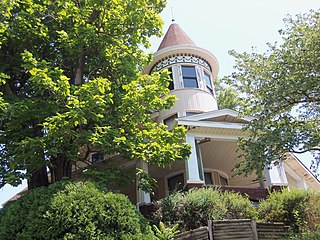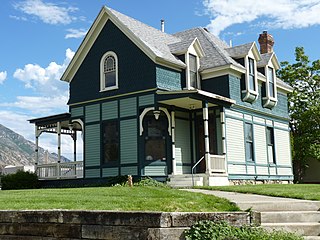
The Grenville M. Dodge House is a historic house museum in Council Bluffs, Iowa, United States. This Second Empire mansion, built in 1869, was the home of Grenville M. Dodge (1831-1916), a Union Army general, politician, and a major figure in the development of the railroads across the American West. The house was declared a National Historic Landmark in 1961 for its association with Dodge; in 2005 it was included as a contributing property in the Willow-Bluff-3rd Street Historic District. It is now owned by the city of Council Bluffs and is open for tours.

The W. C. Baker House is an airplane bungalow located at 301 E. Commerce in the city of Altus, Oklahoma. The house was built in 1917 for the sister of William Clarence Baker; however, Baker bought the house shortly afterward. Baker owned a local machine shop and cotton gin, and he served on Altus' original city council. The house has a typical airplane bungalow plan with a small second story above a low, multi-component first-floor roof, a design reminiscent of an airplane's cockpit. The house's design also includes many characteristic features of the Craftsman style, including overhanging eaves and exposed rafter tails. The porch features battered columns supporting its roof and decorative stickwork in its gable, both of which are typical Craftsman elements.

The Henry Kahl House is a historic building located on a bluff overlooking the West End of Davenport, Iowa, United States. What was a private residence was converted into a nursing home in 1955, and a senior apartment facility in 2016. The house was listed on the National Register of Historic Places in 1983.

The Lewis M. Fisher House is a historic building located on the east side of Davenport, Iowa, United States. It has been listed on the National Register of Historic Places since 1983.

The Charles Whitaker House is a historic building located on the east side of Davenport, Iowa, United States. It has been listed on the National Register of Historic Places since 1985.

W. J. Hughes Business House, also known as C.J. Wilson Store, is located at 70 Ocoee Street in Cleveland, Tennessee, United States. It was listed on the National Register of Historic Places in 1975.

The John Schricker House is a historic building located in the far West End of Davenport, Iowa, United States. The house has been listed on the National Register of Historic Places since 1985.

The Cass County Courthouse in Atlantic, Iowa, United States, was built in 1934 as the first courthouse in the state built with funding from the Public Works Administration (PWA). It was listed on the National Register of Historic Places in 2003 as a part of the PWA-Era County Courthouses of Iowa Multiple Properties Submission. The courthouse is the third structure to house court functions and county administration.

The William D. Alexander House is a historic house located in Provo, Utah. It is listed on the National Register of Historic Places. It is asserted to be the only period example of Stick Style architecture in the state of Utah.

The George M. Brown House is a historic residence in Provo, Utah, United States, that is listed on the National Register of Historic Places. It was built as a home for a "polygamous wife" of lawyer George M. Brown. It is listed on the National Register of Historic Places.

The Bennett Building, also known as the Ervin Building is an historic building located in downtown Council Bluffs, Iowa, United States. The previous building to occupy this property was a Woolworth's that was destroyed in a fire in 1922. The Bennett Building Corporation was formed in 1923 to build an office building that was designed to attract medical professionals. The seven-story, brick, Early Commercial structure was designed by local architectural firm Jensen and Larson, and the Omaha firm of McDonald and McDonald served as the supervising architects. E. A. Wickham and Company of Council Bluffs was the contractor.

The Floyd B. Brown House is a historic house at 1401 South Georgia Street in Pine Bluff, Arkansas. It is a single-story vernacular brick structure, with a gable roof and brick foundation. Decorative elements on the building are minimal, with scalloped trim elements at the gables and eaves, and a fanlight in the front-facing gable. The house was built in 1954 for Floyd and Lillian Brown. The Browns were prominent African-American educators: Floyd Brown founded the Fargo Training School in Fargo, Arkansas, and his wife Lillian taught there.

The August Beresheim House is an historic building located in Council Bluffs, Iowa, United States. Beresheim served as the president of Council Bluffs Savings Bank. His house was built in 1899 in a neighborhood where many influential citizens of that city resided. It is next door to the Grenville M. Dodge House, who instrumental in establishing the bank, and they are the only two residences on their side of street. The three-story frame house is a combination of several styles. The dominant feature of this symmetrical-plan structure is its wrap-around porch. It was listed on the National Register of Historic Places in 1976. In 2005 it was included as a contributing property in the Willow-Bluff-3rd Street Historic District.

The Thomas E. Cavin House is a historic building located in Council Bluffs, Iowa, United States. Built in 1887, it is an unusual and well-preserved brick example of an eclectic combination of Colonial Revival, Gothic Revival, and Queen Anne architectural elements. Cavin owned a dry goods store nearby. He lived here until he died in 1911, and the house remained in the family until 1919. At some point it had been converted into apartments. The house was damaged in a fire in 1934, and had to be partially rebuilt, especially the roof. The front porch is not original.

The Lysander Tulleys House is a historic building located in Council Bluffs, Iowa, United States. Born in Ohio, Tulleys was a school teacher and served in the Civil War before settling in Council Bluffs where he was a partner in Burnham-Tulleys, which provided agricultural loans. In the 1890s they expanded their partnership and entered into real estate, which helped them survive the decade's economic downturn. This 2½-story brick Victorian house was designed by Chicago architect P.E. Hale, and built by Wickham Brothers, a local contractor. The focal point is a three-story square tower capped by a mansard roof with dormers. Its first two stories are brick and the third story is wood with corner pilasters. The friezes above the windows of the main facade are concrete. The other decorative elements are rather simple and include plain cornices and relatively unadorned porches.

State Savings Bank, also known as the Old Savings Bank, is a historic building located in Council Bluffs, Iowa, United States. the bank was established in 1889, and was originally located across the street. Planning for this building began in 1941 with the organization of the State Investment Company, which would build and own the building. It was designed by W.G. Knoebel and built by St. Louis-based Bank Building and Equipment Corporation of America. It is a late example of Art Deco, and it's the only building in Council Bluffs that exhibits this style. Two-thirds of the building is a single-story banking facility, and the rest is divided into two-stories of office space. It has one of the first drive-through teller windows in Iowa. The rectangular building's exterior is finished in gray limestone on two elevations, and a wrap-around continuation on a third. Its primary decorative feature is an inscribed harvest motif on the east and west elevations that are mirror images of each other, oriented to the north. The motif features a male nude holding a wagon wheel and a scythe, with sheaves of wheat and a dog.

The Hughes-Irons Motor Company is a historic building located in Council Bluffs, Iowa, United States. Floyd Hughes and George Irons established an automobile sales and service business selling Ford cars and tractors. They built the eastern six bay section of this building in 1917. The two-story brick structure exhibits elements of the Mission Revival style. Irons left the partnership three years later and was replaced by Parmer. Hughes-Parmer added the four western bays in 1923, before the business split into two different companies. Parmer maintained the Ford dealership in the original building and Hughes opened a Chevrolet dealership in the addition. Parmer was replaced by the Atlantic Auto Company in 1930. They were the first in a long line of automobile repair shops and dealerships that occupied the original section of the building. Hughes remained in the addition until 1979, although they expanded into the neighboring building to the west in 1944. Restoration of the building began in 2008, reversing the alterations done to its main facade. The local chamber of commerce occupies the main floor, and the second floor was converted into apartments. J. Chris Jensen was the architect, and the building was listed on the National Register of Historic Places in 2011.

The Lincoln–Fairview Historic District is a nationally recognized historic district located in Council Bluffs, Iowa, United States. It was listed on the National Register of Historic Places in 2007. At the time of its nomination the district consisted of 327 resources, including 264 contributing buildings, two contributing sites, four contributing structures, three contributing objects, 52 non-contributing buildings, and two non-contributing structures. The district is primarily a residential area north of the central business district. It includes the steep loess bluff where President Abraham Lincoln stood to survey the area when he was deciding on the eastern terminus of the Union Pacific Railroad. The Daughters of the American Revolution erected a monument at the location in 1911.

The Haymarket Commercial Historic District is a nationally recognized historic district located in Council Bluffs, Iowa, United States. It was listed on the National Register of Historic Places in 1985. At the time of its nomination the district consisted of 28 resources, including 19 contributing buildings, and nine non-contributing buildings. "Haymarket" is the forked-junction of Main and Pearl Streets where the city's scales were located in the 1890s. It is on the south side of the central business district. Council Bluffs was founded in the late 1840s as Kanesville by Mormons. When Brigham Young called all people of the faith outside of Utah to Salt Lake City in 1852, the community ceased to be majority Mormon. It was renamed Council Bluffs in 1853. The buildings here are among the earliest extant commercial buildings in the city.

The Rogers-Knutson House is a historic building located in Clear Lake, Iowa, United States. Built in 1895, the Queen Anne Victorian house was built for Francis M. Rogers. He was a farmer, served in the Civil War, was the clerk of court and ran a clothing store in Mason City before he bought the private First National Bank in Clear Lake in 1889. He went on to serve on the board of education, city council, and as mayor of Clear Lake. Clarence and Hazel Knutson bought the house in 1920. Clarence was also a banker and served as mayor. Knutson worked in the family hardware store, served in the Iowa Legislature, and served as the president of the Iowa Hardware Mutual Insurance Company from 1931 to 1960. Hazel Knutson was involved with a variety of civic clubs and organizations, including conservation efforts. She also served as president of the Iowa League of Women Voters. Howard and Francie Sonksen bought the house in 1972. Howard was a teacher and Francie worked from home as a massage therapist. They brought the home back to its original glory, such as removing the wall-to-wall carpeting, refinishing the beautiful wood floors, restoring the solarium and the outside pond pumps back to working order.


























